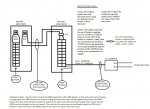rburnham
Member
- Location
- Gilbert, AZ USA
Hi,
I am trying to get my 3-line electrical diagram approved by my local utility (SRP) in Arizona - I have already gotten approval from my AHJ. They have a problem with my proposed wire size going from my 200A aux breaker on my 400A main panel to my proposed 400A subpanel which will be connected to the 200A aux breaker located in the main panel. They asked me to send them a 3-line diagram with supporting NEC code that shows that the wire size proposed would be adequate. I attached what I sent to them here. This is their reply back to me:
According to NEC Section 705.12(D)(2) which states that ?the sum of breakers supplying power to a busbar or conductor shall not exceed 120% of the rating of the busbar or conductor?. The sum of the overcurrent devices (breakers) from both source of power adds up to be 325A (200A + 125A). According to this design, the governing component (busbar or conductor) between both overcurrent devices (breakers) would be the 2/0 CU rated for about 200A. Using the NEC requirement stated above, this design fails because 120% of 200A equals 240A .
My point to them is that the only way the wire feeding the subpanel can ever even see 200A is if there was a load on the subpanel that equaled 325A. That would allow 200A to come from the grid, and 125A come from the solar array. Also, the 2 inverters that will be backfeeding can only put out a max of 41.6A, but due to the 125% over-rating rule for breakers, I had to round up to 60A breakers, and then 125A combined breaker. So in reality, there can never be more than 84A being backfeed into the subpanel. Please let me know if this makes since and who is right on this one. Thanks.
I am trying to get my 3-line electrical diagram approved by my local utility (SRP) in Arizona - I have already gotten approval from my AHJ. They have a problem with my proposed wire size going from my 200A aux breaker on my 400A main panel to my proposed 400A subpanel which will be connected to the 200A aux breaker located in the main panel. They asked me to send them a 3-line diagram with supporting NEC code that shows that the wire size proposed would be adequate. I attached what I sent to them here. This is their reply back to me:
According to NEC Section 705.12(D)(2) which states that ?the sum of breakers supplying power to a busbar or conductor shall not exceed 120% of the rating of the busbar or conductor?. The sum of the overcurrent devices (breakers) from both source of power adds up to be 325A (200A + 125A). According to this design, the governing component (busbar or conductor) between both overcurrent devices (breakers) would be the 2/0 CU rated for about 200A. Using the NEC requirement stated above, this design fails because 120% of 200A equals 240A .
My point to them is that the only way the wire feeding the subpanel can ever even see 200A is if there was a load on the subpanel that equaled 325A. That would allow 200A to come from the grid, and 125A come from the solar array. Also, the 2 inverters that will be backfeeding can only put out a max of 41.6A, but due to the 125% over-rating rule for breakers, I had to round up to 60A breakers, and then 125A combined breaker. So in reality, there can never be more than 84A being backfeed into the subpanel. Please let me know if this makes since and who is right on this one. Thanks.


